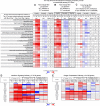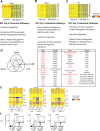Analysis of Transcriptional Signatures in Response to Listeria monocytogenes Infection Reveals Temporal Changes That Result from Type I Interferon Signaling
- PMID: 26918359
- PMCID: PMC4768944
- DOI: 10.1371/journal.pone.0150251
Analysis of Transcriptional Signatures in Response to Listeria monocytogenes Infection Reveals Temporal Changes That Result from Type I Interferon Signaling
Abstract
Analysis of the mouse transcriptional response to Listeria monocytogenes infection reveals that a large set of genes are perturbed in both blood and tissue and that these transcriptional responses are enriched for pathways of the immune response. Further we identified enrichment for both type I and type II interferon (IFN) signaling molecules in the blood and tissues upon infection. Since type I IFN signaling has been reported widely to impair bacterial clearance we examined gene expression from blood and tissues of wild type (WT) and type I IFNαβ receptor-deficient (Ifnar1-/-) mice at the basal level and upon infection with L. monocytogenes. Measurement of the fold change response upon infection in the absence of type I IFN signaling demonstrated an upregulation of specific genes at day 1 post infection. A less marked reduction of the global gene expression signature in blood or tissues from infected Ifnar1-/- as compared to WT mice was observed at days 2 and 3 after infection, with marked reduction in key genes such as Oasg1 and Stat2. Moreover, on in depth analysis, changes in gene expression in uninfected mice of key IFN regulatory genes including Irf9, Irf7, Stat1 and others were identified, and although induced by an equivalent degree upon infection this resulted in significantly lower final gene expression levels upon infection of Ifnar1-/- mice. These data highlight how dysregulation of this network in the steady state and temporally upon infection may determine the outcome of this bacterial infection and how basal levels of type I IFN-inducible genes may perturb an optimal host immune response to control intracellular bacterial infections such as L. monocytogenes.
Conflict of interest statement
Figures








References
-
- Lorber B. Listeriosis. Clin Infect Dis. 1997;24(1):1–9; quiz 10–1. . - PubMed
Publication types
MeSH terms
Substances
Grants and funding
LinkOut - more resources
Full Text Sources
Other Literature Sources
Medical
Molecular Biology Databases
Research Materials
Miscellaneous

